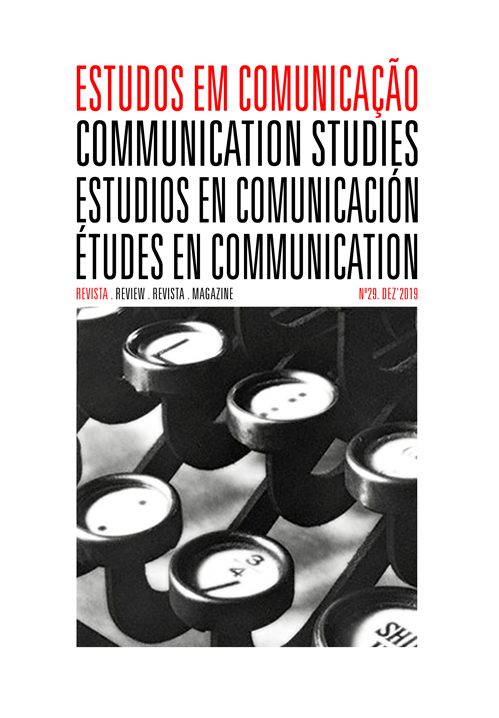Online contents creation: blogging, youtubing and livestreaming under scrutiny
Mots-clés :
creators, users, contents, online, internet, blogging, youtubing, livestreamingRésumé
This article aims at understanding how online communicators establish their communication contents and platforms, in order to maximize public recognition. Qualitative methodology was used, specifically digital content analysis of three case studies: Matthew “Nomadic Matt” Kepnes, Byron Talbott, and Octavian “Kripparian” Morosan. Results allowed verifying that contents are adapted to the platform used. Blogging allows the appearance of longer narratives, while youtubing and livestreaming rely more on communicator’s posture and his/her interaction with the audience.
Références
Ahmed, M., Spagna, S., Huici, F. & Niccolini, S. (2013). A Peek into the Future: Predicting the Evolution of Popularity in User Generated Content. In Proceedings of the sixth ACM international conference on Web search and data mining (pp. 607-616). Rome, Italy: Association for Computing Machinery. https://doi.org/ 10.1145/2433396.2433473
Berger, J., & Iyengar, R. (2013). Communication channels and word of mouth: How the medium shapes the message. Journal of Consumer Research, 40(3), 567-579. https://doi.org/ 10.1086/671345
Blog Rank. (2014). Blog Rank. Retrieved from http://www.blogmetrics.org/.
Byron Talbott. (2014). ByronTalbott – YouTube. Retrieved from https://www.youtube.com/user/ByronTalbott
Cantallops, A. S. & Salvi, F. (2014). New consumer behavior: a review of research on eWOM and hotels. International Journal of Hospitality Management, 36, 41-51. https://doi.org/ 10.1016/j.ijhm.2013.08.007.
Chu, S.-C. & Kim, Y. (2011). Determinants of consumer engagement in electronic word-of-mouth (eWOM) in social networking sites. International Journal of Advertising, 30 (1), 47-75. https://doi.org/ 10.2501/IJA-30-1-047-075.
Clark, D. (2014, July 24). How To Make A Living From Blogging. Forbes. Retrieved from http://www.forbes.com/sites/dorieclark/2014/07/24/how-to-make-a-living-from-blogging/.
Halvorsson, K. & Rach, M. (2012). Content Strategy for the Web. Berkeley: New Riders.
Hennig-Thurau, T., Gwinner, K. P., Walsh, G. & Gremler, D. D. (2004). Electronic word-of-mouth via consumer-opinion platforms: what motivates consumers to articulate themselves on the internet?. Journal of Interactive Marketing, 18 (1), 38-52. https://doi.org/ 10.1002/dir.10073
Hennig-Thurau, T., Wiertz, C., & Feldhaus, F. (2015). Does Twitter matter? The impact of microblogging word of mouth on consumers’ adoption of new movies. Journal of the Academy of Marketing Science, 43(3), 375-394. https://doi.org/ 10.1007/s11747-014-0388-3
Kaplan, A. M. & Haenlein, M. (2010). Users of the world, unite! The challenges and opportunities of Social Media. Business Horizons, 53(1), 59-68. https://doi.org/ 10.1016/j.bushor.2009.09.003
Kotler, P., Burton, S., Deans, K., Brown, L. & Armstrong, G. (2013). Marketing. New South Wales: Pearson Australia.
Kripparian. (2015a). Nl_kripp – Twitch. Retrieved from: http://www.twitch.tv/nl_kripp.
Kripparian. (2015b). Kripparian. Retrieved from: http://kripparrian.com/.
Litvin, S. W., Goldsmith, R. E., & Pan, B. (2008). Electronic word-of-mouth in hospitality and tourism management. Tourism Management, 29 (3), 458-468. https://doi.org/ 10.1016/j.tourman.2007.05.011
Liu, Q., Karahanna, E. & Watson, R. T. (2011). Unveiling user-generated content: Designing websites to best present customer reviews. Business Horizons, 54(3), 231-240. https://doi.org/ 10.1016/j.bushor.2011.01.004
Lobato, R., Thomas, J. & Hunter, D. (2011). Histories of User-Generated Content: Between Formal and Informal Media Economies. International Journal of Communication, 5, 899-914.
Lyngbo, T. (2012). Power Social Media Marketing: Today and Tomorrow. Retrieved from powersocialmediamarketing.com/.
Maguire, J. S. & Matthews, J. (2014). The Cultural Intermediaries Reader. London: Sage Publications Ltd.
Nomadic Matt. (2014). Nomadic Matt’s Travel Site: Travel Cheaper, Better, Longer. Retrieved from: http://www.nomadicmatt.com/.
Pew Research Internet Project. (2014). Social Media Update 2013. Retrieved from: http://www.pewinternet.org/2013/12/30/social-media-update-2013/#fn-6228-1.
Saveur. (2014). Best Food Blog Awards 2014: Winners. Retrieved from: http://www.saveur.com/content/best-food-blog-awards-2014-winners.
Schau, H. J. & Gilly, M. C. (2003). We are what we post? Self-presentation in personal web space. Journal of Consumer Research, Inc., 30(3), 385-404. https://doi.org/ 10.1086/378616
Shuen, A. (2008). Web 2.0: A Strategy Guide. Sebastopol, Canada: O’Reilly Media, Inc..
Social Blade. (2014). YouTube Statistics, Twitch Statistics, Instagram Statistics – SocialBlade.com. Retrieved from: http://socialblade.com/
Solis, B. & Breakenridge, D. (2009). Putting the Public Back in Public Relations. Pearson Education, Inc., New Jersey: FT Press.
Statista. (2014). Number of monthly active Facebook users worldwide from 3rd quarter 2008 to 3rd quarter 2014 (in millions). Retrieved from: http://www.statista.com/statistics/264810/number-of-monthly-active-facebook-users-worldwide/
Stuczynski, T. (2014). The Impact of Innovation: Entertainment. CreateSpace Independent Publishing Platform.
The Richest. (2014). Top 10 Most Subscribed “YouTubers”. Retrieved from: http://www.therichest.com/rich-list/most-popular/top-10-most-subscribed-youtubers/.
Vickery, G., & Wunsch-Vincent, S. (2007). Participative web and user-created content: Web 2.0 wikis and social networking. Organization for Economic Cooperation and Development (OECD). Retrieved from http://www.oecd-ilibrary.org/docserver/download/9307031e.pdf?expires=1519750107&id=id&accname=guest&checksum=8C34EC937104DF5F277EA78AF703CDF0.
Weinberg, B. D. & Berger, P. D. (2011). Connected customer lifetime value: The impact of social media. Journal of Direct, Data and Digital Marketing Practice, 12 (4), 328-344. https://doi.org/10.1057/dddmp.2011.2
Zarrella, D., & Zarrella, A. (2011). The Facebook marketing book. Sebastopol, Canada: O'Reilly Media, Inc.


